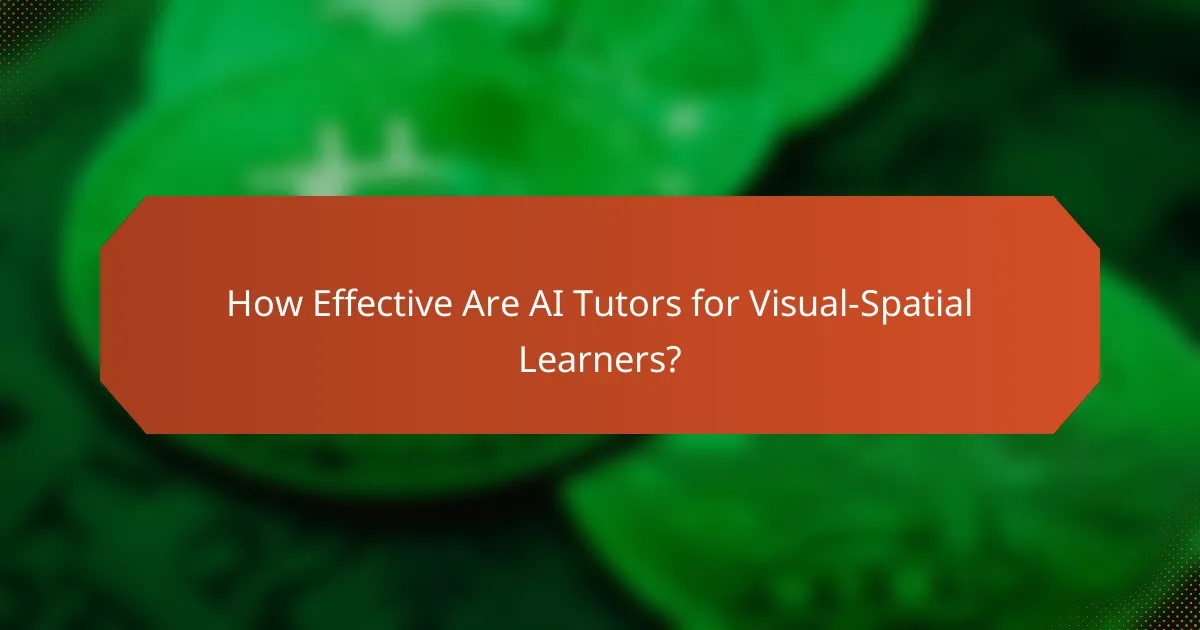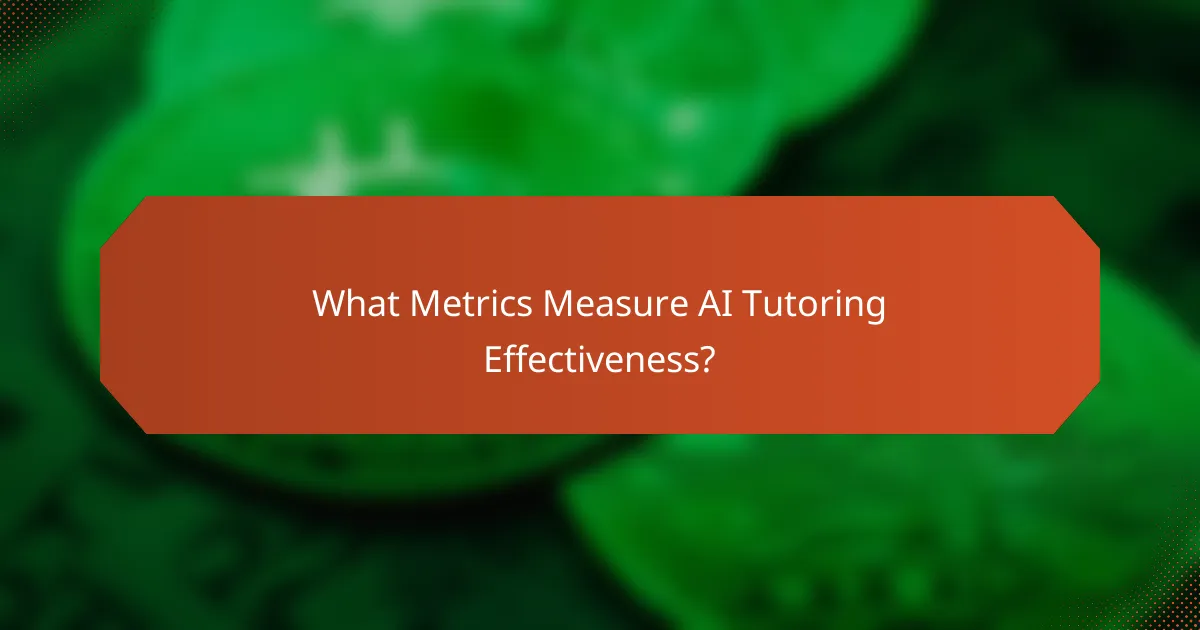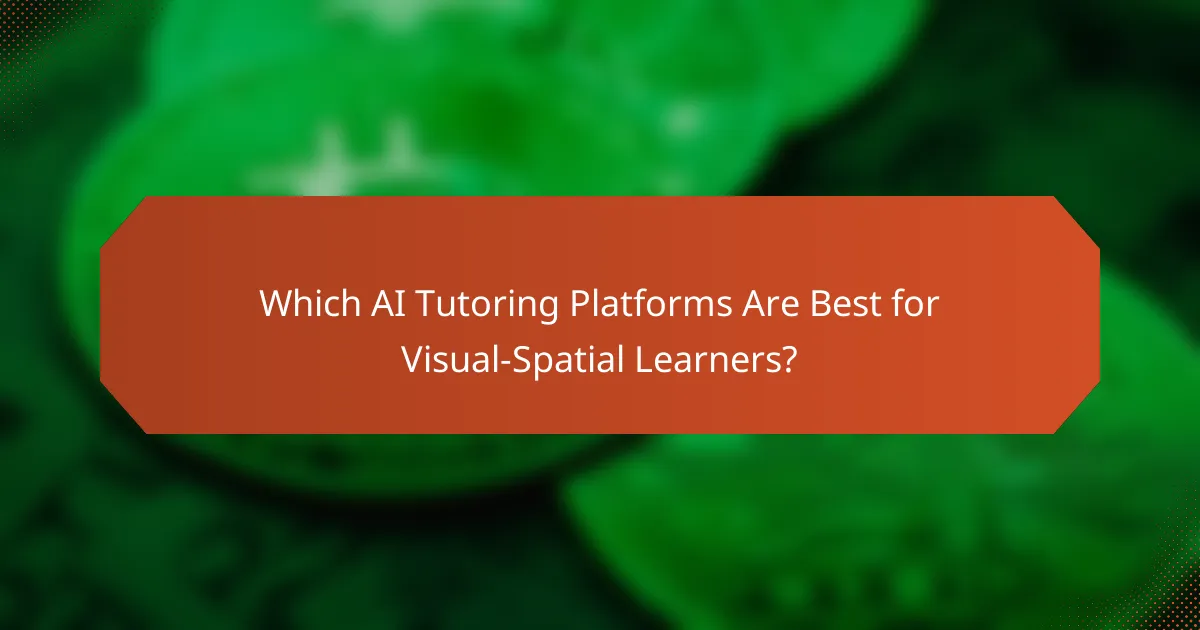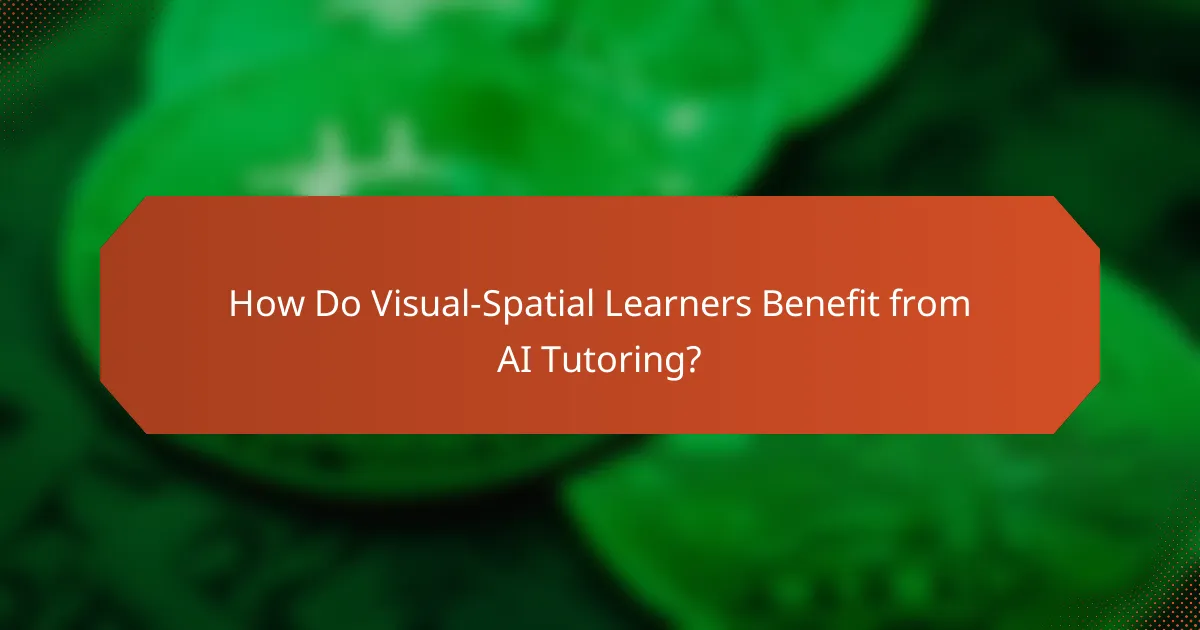AI tutoring has emerged as a powerful tool for visual-spatial learners, offering personalized support that caters to their distinct learning preferences. By leveraging interactive and visually engaging methods, these platforms can significantly enhance comprehension and retention of information. To gauge the effectiveness of AI tutoring, it is essential to assess metrics such as student performance, engagement levels, and overall satisfaction with the learning experience.

How Effective Are AI Tutors for Visual-Spatial Learners?
AI tutors can be highly effective for visual-spatial learners by providing tailored support that aligns with their unique learning styles. These learners often excel when information is presented visually, and AI tools can enhance their understanding through interactive and engaging methods.
Improved engagement and retention
AI tutors increase engagement by utilizing visual aids, simulations, and interactive content that resonate with visual-spatial learners. This approach not only captures their attention but also helps in retaining information more effectively. For instance, using 3D models or visual storytelling can significantly enhance a learner’s ability to remember concepts.
Retention rates can improve when learners interact with content that is visually stimulating. Studies suggest that learners who engage with visual materials may retain information for longer periods compared to traditional text-based methods.
Personalized learning experiences
AI tutors can create personalized learning pathways tailored to the strengths and weaknesses of visual-spatial learners. By analyzing individual performance data, these systems can adjust the difficulty and type of content presented, ensuring that learners remain challenged yet not overwhelmed.
For example, an AI tutor might offer more visual puzzles or spatial reasoning exercises for a learner struggling with geometric concepts, thereby catering to their specific needs and enhancing their overall learning experience.
Data-driven performance metrics
AI tutors provide valuable insights through data-driven performance metrics, allowing educators and learners to track progress effectively. These metrics can include engagement levels, time spent on tasks, and accuracy rates, which are crucial for understanding a learner’s development.
By regularly reviewing these metrics, educators can identify trends and make informed decisions about instructional strategies. For instance, if a visual-spatial learner consistently performs well on visual tasks but struggles with verbal instructions, adjustments can be made to focus more on visual content delivery.

What Metrics Measure AI Tutoring Effectiveness?
Measuring AI tutoring effectiveness involves evaluating various metrics that reflect student progress and engagement. Key metrics include student performance improvement, engagement levels, and feedback and satisfaction ratings.
Student performance improvement
Student performance improvement is often assessed through pre- and post-assessments that gauge knowledge retention and skill acquisition. For visual-spatial learners, improvements may be measured in areas such as problem-solving abilities and spatial reasoning skills, typically showing gains of 10-30% after targeted AI tutoring sessions.
To effectively measure this improvement, educators can use standardized tests or specific assessments tailored to the subject matter. Tracking progress over time helps identify trends and areas needing further support.
Engagement levels
Engagement levels indicate how actively students participate in the tutoring process. Metrics such as time spent on tasks, frequency of interactions with the AI, and completion rates of assigned activities can provide insights into student engagement. Visual-spatial learners may benefit from interactive elements like simulations or visual aids, which can enhance their involvement.
Educators should monitor these metrics regularly to ensure that the AI tutoring platform maintains high engagement. A drop in engagement may signal the need for adjustments in content delivery or the introduction of new interactive features.
Feedback and satisfaction ratings
Feedback and satisfaction ratings are crucial for understanding the overall effectiveness of AI tutoring. Surveys and questionnaires can be utilized to gather student opinions on their learning experiences, focusing on aspects such as clarity of explanations and the relevance of materials. A satisfaction rating of 80% or higher is generally considered a positive outcome.
Incorporating feedback loops allows for continuous improvement of the AI tutoring system. Regularly updating content based on student input can enhance satisfaction and ensure that the tutoring remains aligned with learner needs.

Which AI Tutoring Platforms Are Best for Visual-Spatial Learners?
AI tutoring platforms that cater to visual-spatial learners typically incorporate interactive and visual elements to enhance understanding. These platforms often utilize graphics, simulations, and engaging interfaces to facilitate learning for students who excel in spatial reasoning.
Khan Academy
Khan Academy offers a wide range of subjects with a focus on visual learning through videos and interactive exercises. Its platform includes instructional videos that break down complex concepts into digestible segments, often using animations and diagrams that appeal to visual-spatial learners.
Students can track their progress and revisit challenging topics, making it a flexible option for individualized learning. The platform is free, providing access to high-quality resources without any financial barriers.
DreamBox Learning
DreamBox Learning specializes in math education and adapts its lessons based on student interactions, making it highly personalized. The platform uses visual representations and interactive games to teach mathematical concepts, which can be particularly beneficial for visual-spatial learners.
With a subscription model, DreamBox Learning charges a monthly fee, but it often provides trial periods for new users. The adaptive nature of the platform ensures that learners are engaged and challenged appropriately.
IXL Learning
IXL Learning covers a broad array of subjects, including math and language arts, and emphasizes practice through interactive questions. The platform provides immediate feedback and visual progress tracking, which helps visual-spatial learners see their improvement over time.
IXL operates on a subscription basis, offering different pricing tiers based on the subjects selected. Its comprehensive analytics can help educators and parents identify areas where students may need additional support.

What Are the Key Features of Effective AI Tutoring?
Effective AI tutoring for visual-spatial learners incorporates features that enhance engagement and understanding. Key elements include adaptive learning algorithms, interactive visual aids, and real-time feedback, all tailored to meet the unique needs of these learners.
Adaptive learning algorithms
Adaptive learning algorithms personalize the educational experience by adjusting content and difficulty based on individual performance. These systems analyze a learner’s strengths and weaknesses, often in real-time, to provide customized pathways that enhance retention and comprehension.
For visual-spatial learners, algorithms can prioritize tasks that involve spatial reasoning and visual problem-solving, ensuring that the material resonates with their learning style. This targeted approach can significantly improve learning outcomes compared to a one-size-fits-all method.
Interactive visual aids
Interactive visual aids are crucial for engaging visual-spatial learners, as they facilitate understanding through dynamic representations of concepts. Tools such as 3D models, simulations, and infographics help learners visualize complex information, making it easier to grasp abstract ideas.
Incorporating these aids into AI tutoring platforms can lead to better retention rates. For instance, using interactive diagrams to explain geometric principles allows learners to manipulate objects and see the effects of their actions, reinforcing their understanding through hands-on experience.
Real-time feedback
Real-time feedback is essential for effective learning, as it allows students to understand their mistakes and correct them immediately. AI tutoring systems can provide instant evaluations of responses, guiding learners towards the right solutions and enhancing their problem-solving skills.
This immediate feedback loop is particularly beneficial for visual-spatial learners, who may require more time to process information. By receiving timely insights, they can adjust their strategies and improve their performance without the delay of traditional feedback methods.

How Do Visual-Spatial Learners Benefit from AI Tutoring?
Visual-spatial learners can significantly benefit from AI tutoring by engaging with interactive and visual content tailored to their learning style. These learners often excel in understanding and manipulating visual information, making AI tools that utilize graphics, simulations, and spatial reasoning exercises particularly effective.
Enhanced problem-solving skills
AI tutoring can enhance problem-solving skills in visual-spatial learners by providing dynamic scenarios that require critical thinking and creativity. For example, platforms that simulate real-world challenges allow learners to visualize problems and explore multiple solutions, fostering a deeper understanding of concepts.
Through adaptive learning algorithms, AI can adjust the difficulty of problems based on the learner’s performance, ensuring they are consistently challenged without feeling overwhelmed. This tailored approach helps build resilience and confidence in tackling complex tasks.
Improved spatial reasoning
Spatial reasoning is crucial for visual-spatial learners, and AI tutoring can improve this skill through targeted exercises and interactive tools. Programs that incorporate 3D modeling or virtual reality can help learners visualize spatial relationships and manipulate objects in a digital environment, enhancing their understanding of geometry and physics.
To maximize benefits, learners should engage with AI tools that offer a variety of spatial tasks, such as puzzles or design challenges. Regular practice with these resources can lead to noticeable improvements in their ability to visualize and solve spatial problems effectively.
